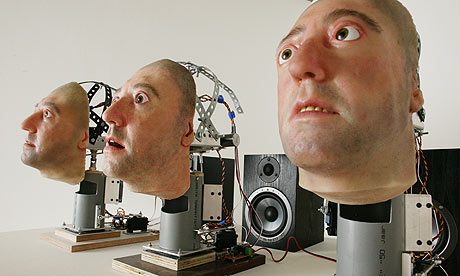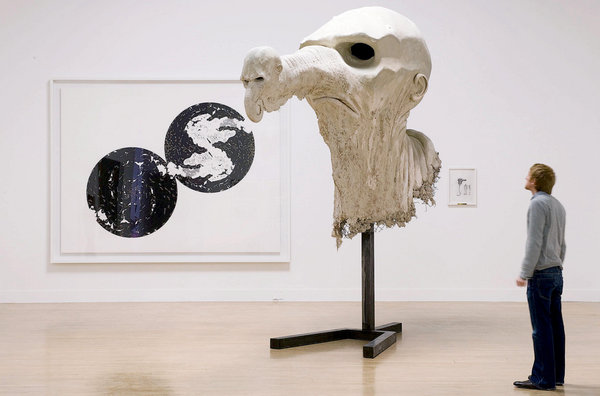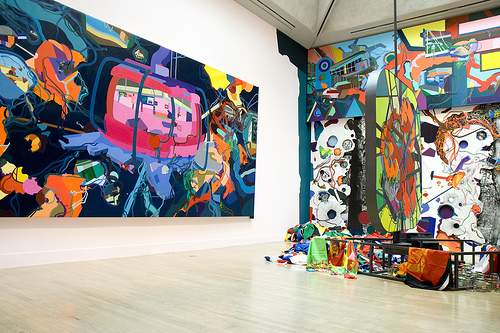
Nicolas Bourriaud’s Altermodern contends that in modern society increased communication, travel and migration irrevocably alter the way we live. This chaotic everyday has created a dislocated society. Today’s art, we are told, explores the bonds that text and image, time and space, weave between themselves. We are now encountering a networked form of modernity and the altermodern embodies this art of discursive exchange. This meta-narrative of a new form of modernism is an open network of artist intent, each functioning for themselves in the communal investigation of what it is to be an artist today. Many artists came under the Altermodern rubric, yet certain artists excelled in maintaining their autonomy. One can argue that a communal-based self-exploration can lead to dry, over-personalised work; however, this does not appear to be the case for most of the artists in Altermodern.
Franz Ackerman’s <Gateway>-Getaway (2008-09) places the viewer in an event where our baggage, both physically and emotionally, is examined. Investigating the conditions of travel, real events are portrayed in a processional format. Hyper-bright colours create a consistent visual bombardment. Shall we remain, our identities intact, or will we change inexorably? This work deals with connotations of air travel and the host of problems this has recently thrown – up the airport as a no-man’s land, an end-zone, a start-zone, all depending on who and where we are.
These ideas are embodied in Ackerman’s installation through the vestures of today’s traveller. Flags represent our hopes and dreams, now strewn haphazardly across an unknown room. One thinks of ripped-open luggage. The room walls are covered in bright murals, now synonymous with Ackerman, suggesting the artist as individual is being represented. A cage runs down the middle of the room and one side is filled with felled flags, a turntable mural and a monitor looping a clip of Pat Garrett and Billy the Kid (1973). One feels confined, confused and processed, within this intensified zone imposed upon us. This vision is unnaturally amplified in Technicolor and the monitor clip replays James Coburn asking Bob Dylan, “Who are you?" Exactly, who are we and what defines us? To whom do we belong and at what price our safety?

Charles Avery’s Aleph null head (2008) and Installation of drawings (2009) propose the idea of artist as explorer. Avery associates the investigatory elements of artistic practice with that of a philosopher, scientist and mathematician. In essence, we are all looking for the truth of ourselves. Art as product, a non-sequitur in postmodernism, allowable in the altermodern, is rationally met within Avery’s work as the embodiment of investigation. The installation consists of the mounted head of the mythological Aleph around which are hung cartoon-style sketches with hunting groups surveying a desert scene and culminating in museum-goers pontificating upon the dried specimen. The artificiality of the museum environs is acknowledged, how living things mutate, alter and decay within the confines of the museum. This installation is part of Avery’s evolving project The Islanders. The Aleph head and drawings examine ideas of ownership and colonisation. Are we all eventually to be stuffed and displayed as relics?
Louis Gréaud tells us he created his work Tremors where forever (frequency of an image, white edit) (2008) in association with a neurologist who maps the output of the artist-brain. One hopes that his inspiration can be elucidated, yet amusingly the work is as obscure as any neuronal network, though perhaps this was the point. The artist has created projections and trajectories in wires throughout a small room, each fusing together in a techno-synapse. A box emits a buzz, resonating when a thought or information feeds into it. The circuit feeds along the floor into a large central blinking box. The brain network idea goes so far, but what appealed to me more about this work was the bodily character to it. One enters the piece and can move around in tandem to the buzz of inspiration. We can project, onto the piece, our own thoughts and new networks fire within the spectator’s brain. We are essentially re-wiring ourselves in response to the artwork, and what more can one ask of the altermodern?
Nathaniel Mellor’s Giantbum (2009) places the challenge of endurance to the spectator. His amusingly distasteful effluent bubbles up in the dialogue of two videos positioned within pods of a large colon. We walk, unknowingly, into God’s Bum and listen to what those trapped inside have to tell us. This satire explores notions of the self and our relation to art. Are we really all trapped in a bum talking nothing but crap? The journey into the unknown intestine moves us into the second chamber where the players are bemoaning their strife, some praising their good fortune at being eaten by God and the others wondering how they’ll escape. The artist, adorned in Faustian garb, pronounces that inside is outside and vice versa, they will never escape. Just when we are full of talk of the fetid we move on through and reach a startlingly white room with three animatronic heads, uncanny in their freakish realism. Has one reached the artist brain, ironically situated in the bum? The heads gesture and eye you as they spell, sing and shout ‘E-X-I-T’. We are done and must be removed; enlightenment has been reached, it seems.

The highlight of the show for me was Lindsay Seers’s Extramission 6 (Black Maria) (2009). Through a closely shot interview with numerous narrators, Seers’s mother amongst them, we hear how the artist evolved into a camera. Cameo-style shots of the artist in a tent follow and we learn to empathise with the little girl who found her voice late in life and then rued her discovery. The artist moves into image-making to resolve this issue, eventually becoming a projector, shining a light on all she sees rather than taking it. Her mother sees this as a positive move. The film is projected into a darkened room inside a mock-up copy of Thomas Edison’s Black Maria, arguably the first movie studio. Elloquent and touching, Seers marks the journey into the altermodern with a pathos rarely found in contemporary art.
That the journey is the resolve of many of the artists in Altermodern means we face a constant evaluation of the self as we move through the show. This intensified scrutiny could become tiresome; however, many of the truly successful works featured manage to assuage any trepidation we may feel at such a grand detour. Living up to such an auspicious curator as Bourriaud weighs heavily on some of the artists; those that are truly successful amuse in their light-hearted yet multi-layered take on the altermodern. One feels that some of the artists engaged in too much dialogue with the curator, and their turn to self-over-evaluation ended up tying them in knots. The highlights are thankfully in the majority, and Altermodern doesn’t disappoint.
(The work of Subodh Gupta, Spartacus Chetwynd, Simon Starling, Marcus Coates and Mike Nelson are also worth a look.)
Hilary Murray is a critic and MA student at NCAD.
